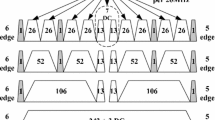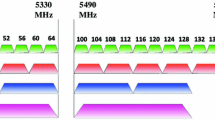Abstract
With the dense deployment of basic service set (BSS) in the next generation Wireless Local Access Network (WLAN). The overlapping coverage of multiple BSSs leads to intensified contention conflicts, low efficiency of buffer state reports (BSR) collection and a sharp decline in system throughput. To solve this problem, this paper proposes an access point (AP) cooperation based multi-BSS multi-user full duplex multiple access protocol (CMMFD). Firstly, access control (AC) divides the STAs in the cooperative network area into overlapping STA and non-overlapping STA. A bi-level channel resource allocation algorithm is designed. The first level is channel resource allocation in the collection stage of BSR and inter-node interference information (BI), and the second level is channel resource allocation in full duplex data transmission. Secondly, a protocol framework for parallel BI information collection of cooperative APs is designed. AC schedules cooperative APs to send trigger frame at the same time, and triggers STAs in each BSS to report BI information on the assigned channel resource with \(p\)-probability access mode. Finally, AP forwards the collected BI information to AC, and AC assigns the STAs in the multi-BSS to perform multi-user full-duplex transmission on the resource unit (RU). Theoretical analysis gives the closed form expressions of the mean number of STAs successfully collected by AC in the cooperation area and saturated network throughput. Simulation results show that compared with MU-FuPlex and EnFD-OMAX protocol, CMMFD protocol improves the network throughput by 29.6% and 31.2% respectively.










Similar content being viewed by others
References
Cisco (2017) Cisco visual networking index: Global mobile data traffic forecast update, 2016-2021 white paper, Cisco, Jialefuniya, America, Tech. Rep. Cisco white paper. Available: https://www.cisco.com/c/en/us/solutions/collateral/service-provider/visualnetworking- index-vni/mobile-white-paper-c11-520862.html
IEEE P802.11-Task Group BE (EHT) (2020) Meeting update. Available: http://www.ieee802.org/11/Reports/tgbe_update.htm. Accessed 8 Jan 2020
David L-P, Adrian G-R, Lorenzo G-G et al (2019) IEEE 802.11be Extremely High Throughput: The Next Generation of Wi-Fi Technology beyond 802.11ax. IEEE Commun Mag 57:113–119
Deng C, Fang X, Han X et al (2020) IEEE 802.11be Wi-Fi 7: new challenges and opportunities. IEEE Commun Surv Tutor 22(4):2136–2166
Dmitry A, Laurent C, Das D et al (2020) Multi-AP coordination for spatial reuse. IEEE 802. 11-20/0107r1. Available online: https://mentor.ieee.org/802.11/dcn/20/11-20-0107-01-00be-multi-ap-coordination-for-spatial-reuse.pptx. Accessed 13 Jan 2020
Jay Y, Prabodh V, Mika K, et al. (2020) VBSS for multi-AP coordination. IEEE 802. 11-20/1247r0. Available online: https://mentor.ieee.org/802.11/dcn/20/11-20-1247-00-00be-virtual-bss-for-multi-ap-coordination.pptx. Accessed 13 Jan 2020
Yang M, Li B, Yan Z et al (2019) AP coordination and full-duplex enabled multi-band operation for the next generation WLAN: IEEE 802.11be (EHT). In: 2019 11th International Conference on Wireless Communications and Signal Processing (WCSP), vol 2019, Xi’an, pp 1–7. https://doi.org/10.1109/WCSP.2019.8928021
Bian HL, Fang YG, Sun B et al (2020) Co-time co-frequency full duplex for 802.11 WLAN. IEEE 802. 11-13/0765r2. Available online: https://mentor.ieee.org/802.11/dcn/13/11-13-0765-02-0hew-co-time-co-frequency-full-duplex-for-802-11-wlan.ppt. Accessed 17 July 2013
Oteri K, Yang R (2020) Full duplex for 802.11 - FD architecture. IEEE 802. 11/18-1225r0. Available online: https://mentor.ieee.org/802.11/dcn/18/11-18-1225-00-00fd-technical-report-on-full-duplex-for-802-11-fd-architecture.docx. Accessed 9 July 2020
Reiskarimian N, Dastjerdi MB, Zhou J et al (2018) Analysis and design of commutation-based circulator-receivers for integrated full-duplex wireless. IEEE J Solid-State Circuits 53(8):2190–2201
Chu K, Katanbaf M, Zhang T et al (2018) A broadband and deep-TX self-interference cancellation technique for full-duplex and frequency-domain-duplex transceiver applications. IEEE International Solid - State Circuits Conference - (ISSCC), San Francisco, pp 170–172
Kiran R, Mehta NB, Thomas J (2019) Design and network topology-specific renewal-theoretic analysis of a MAC protocol for asymmetric full-duplex WLANs. IEEE Trans Commun 67(12):8532–8544
Ahn H, Park YD, Kim D et al (2019) A full-duplex MAC protocol based on buffer status report for successive full-duplex link setup. IEEE Commun Lett 23(9):1506–1509
Liu S, Fu L, Xie W (2020) Hidden-node problem in full-duplex enabled CSMA networks. IEEE Trans Mob Comput 19(2):347–361
Qu Q, Li B, Yang M et al (2017) MU-FuPlex: A multiuser full-duplex MAC protocol for the next generation wireless networks. In: IEEE Wireless Communications and Networking Conference(WCNC 2017), pp 1–6. https://doi.org/10.1109/WCNC.2017.7925936
Qu Q, Li B, Yang M et al (2018) Power control based multiuser full-duplex MAC protocol for the next generation wireless networks. Mob Netw 23:1008C1019
Peng M, Li B, Yan Z et al (2020) A trigger-free multi-user full duplex user-pairing optimizing MAC protocol. In: Lecture notes of the institute for computer sciences, social-informatics and telecommunications engineering, LNICST: vol. 316 LNICST. Springer Science and Business Media Deutschland GmbH, pp 598–610. https://doi.org/10.1007/978-3-030-44751-9_51
Peng M, Li B, Yan Z et al (2020) A spatial group-based multi-user full-duplex OFDMA MAC protocol for the next-generation WLAN. Sensors 20(14):3826
Saldana J, Ruiz-Max J, Fernandez-Navajas J et al (2021) Attention to Wi-Fi diversity: resource management in WLANs with heterogeneous APs. IEEE Access 9:6961–6980
Stojmenovic I, Lin Xu (2001) Loop-free hybrid single-path/flooding routing algorithms with guaranteed delivery for wireless networks. IEEE Trans Parallel Distrib Syst 12(10):1023–1032
Li Y, Li B, Yang M et al (2019) Multiple BSSs association based spatial clustering group access protocol for next generation WLAN. Xibei Gongye Daxue Xuebao/J Northwest Polytech Univ 37(4):809–815
Chen HJ, Chuang CP, Wang YS et al (2016) Design and implementation of a Cluster-based Channel Assignment in high density 802.11 WLANs. In: 18th Asia-Pacific Network Operations and Management Symposium (APNOMS), Kanazawa, pp 1–5. https://doi.org/10.1109/APNOMS.2016.7737200
Acknowledgements
This work was supported in part by the National Natural Science Foundations of CHINA (Grant No.61771392, 61771390, 61871322 and 61501373) and the Science and Technology on Avionics Integration Laboratory (Grant No. 20185553035 and 201955053002).
Author information
Authors and Affiliations
Corresponding author
Additional information
Publisher's note
Springer Nature remains neutral with regard to jurisdictional claims in published maps and institutional affiliations.
Rights and permissions
Springer Nature or its licensor (e.g. a society or other partner) holds exclusive rights to this article under a publishing agreement with the author(s) or other rightsholder(s); author self-archiving of the accepted manuscript version of this article is solely governed by the terms of such publishing agreement and applicable law.
About this article
Cite this article
Peng, M., Li, B. & Yan, Z. Multi-BSS Multi-User Full Duplex MAC Protocol based on AP Cooperation for the Next Generation WLAN. Mobile Netw Appl 28, 1019–1030 (2023). https://doi.org/10.1007/s11036-023-02132-8
Accepted:
Published:
Issue Date:
DOI: https://doi.org/10.1007/s11036-023-02132-8




